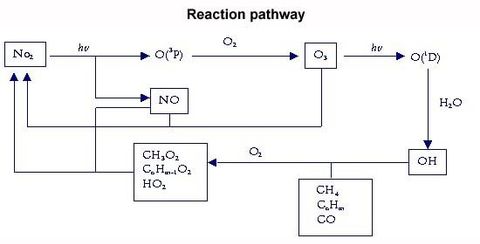GLOBAL TROPOSPHERE
GLOBAL TROPOSPHERE
IMPACT OF AIRCRAFT ON GLOBAL TROPOSPHERE WARMING
In this application, FACSIMILE has been used to determine the relative effects of NOx emissions from surface sources and from aircraft.
Actual and potential increases in aircraft traffic are causing concern about the effects of aircraft exhaust emission on atmospheric chemistry. Model results and measurements in the Northern Hemisphere have shown that growth in surface emissions of nitrogen oxides and hydrocarbons leads to increases in concentration of tropospheric ozone. Tropospheric ozone is toxic to plants, humans and other organisms, and it is a greenhouse gas.
The radiative forcing of surface temperature is most sensitive to changes in tropospheric ozone at a height of ~12km, where the emissions of nitrogen oxides are at a maximum and where model sensitivity of ozone to nitrogen oxide emissions is enhanced. The model developed using FACSIMILE provides results which show that the relative forcing of the surface temperature is about thirty times more sensitive to aircraft emissions of nitrogen oxides than to surface emissions. The model also indicates that the impact on global warming of increases in surface emissions of nitrogen oxides has previously been overestimated by a factor of five.
The composition of an air parcel simulated over several days using FACSIMILE
(Courtesy Mike Jenkin, Imperial College, London)
Previous 2D global modelling of the effects of nitrogen oxide (NOx) emissions from tropospheric aircraft has led to predictions of increases of 1-15% in ozone in a latitudinal band centred at 45°N when aircraft emissions are included. Much of this variation in ozone increase is explained by differences in emission estimates.
In the model developed here using FACSIMILE, a 2D (latitude-altitude) model of the global troposphere to 24km has been developed to simulate the changes in ozone concentrations, and those of other gases, in response to changes in NOx emissions.
The model takes into account the emissions, chemistry, transport and deposition of tropospheric trace gases. The chemical mechanisms are summarised in the adjacent figure, where the inner cycle involves the photo dissociation of NO2 leading to ozone and NO formation, and the subsequent back reaction of these species to regenerate NO2. Competing with this back reaction is the outer cycle involving the formation of peroxy radicals from methane, nonmethane hydrocarbons and carbon monoxide.
The FACSIMILE model was used to construct a baseline case in which there were no aircraft emissions. This was compared to two situations in which estimated values were used for aircraft emissions for the years 1990 and 2000, and with a sensitivity study in which surface NOx emissions from man-made sources were increased by 10%. The results indicate from the distribution of the ozone changes that the model sensitivity to the aircraft NOx emissions is greater in the Southern Hemisphere than in the Northern Hemisphere. The sensitivity of the ozone concentrations to surface NOx emissions is much less than to aircraft emissions and demonstrates the influence of non-linear chemistry on ozone production mechanisms. The model highlights how the absence of direct deposition to ground and slower conversion to nitric acid at lower temperatures lead to longer lifetimes for NOx emitted from aircraft higher in the atmosphere.
This application illustrates how FACSIMILE is an invaluable tool for the development of models involving mixed systems of kinetic reactions and advective mechanisms.



